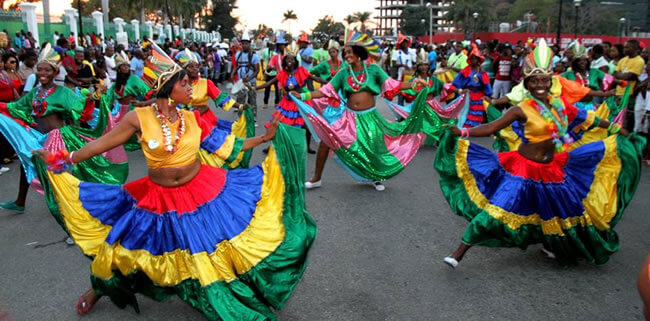Finally, we would like to highlight our Haitian community. Haiti is located on the western third of the Caribbean island of Hispaniola, to the left of the Dominican Republic. Haiti was a French colony until its independence in 1804, and its influences are still evident in the country.
The French brought enslaved Africans to Haiti when it was under colonial rule, so over 90 percent of the country is black today. A little over five percent of the country are descendants of Africans and Europeans, with an even smaller percentage of people of European descent. Haiti has two official languages, Haitian Creole and French. Creole is used for everyday life, whereas French is typically used as a second language in formal situations. Creole comes from French vocabulary but uses the syntax of Caribbean and Indian Ocean Creole languages.
Over half the population practices Roman Catholicism, but combine it with the West African religion of Vodou. Haiti has many other minority religions as well, as its constitution allows for religious freedom.
Haiti has a rich culture full of traditions despite enduring centuries of slavery and colonialism. It is influenced by Africa, France, the Caribbean, and North America, and is uniquely Haitian. The merengue musical style came from the island of Hispaniola, which combines African drum rhythms and 19th-century European dance music. Music and literature both have the possibility to feature political messages, as well as address identity problems Haitians face. Haiti also celebrates festivals such as Rara and Carnival. Rara features music, dance, and religious rituals, and has the potential for political protest. During Rara, people move and dance through the streets, stopping to perform music for people and collect money for their performance. Carnival takes place until Mardi Gras and also features singing, dancing, and costumes.
Haiti is currently the poorest country in the Western Hemisphere, with four-fifths of the population living in poverty. Their resources have been exploited first by French colonists, and then by corruption. Natural disasters such as hurricanes and earthquakes have contributed to poverty and lack of proper medical care. Diseases are prevalent, which are brought on by the lack of safe running water and unsanitary living conditions.
There are many resources that we encourage you to engage with in order to learn more about Haiti. We hope that you will check in with us tomorrow for World Refugee Day and see what you can do to help and advocate for refugees all over the world. We want to give a special thank you to a member of our community for sharing information about Haitian culture and providing the recipes below!
To learn about Rara: https://www.youtube.com/watch?v=79SeT6GZkDI
To learn more about Carnival: https://www.youtube.com/watch?v=bEpVjjmgq70
A Haitian New Year Tradition: Soup Joumou/Pumpkin Soup
One popular tradition that Haitians everywhere participate in is drinking Soup
Joumou (pumpkin soup) on their independence day, January 1st. This soup was
enjoyed by slave masters in the former French colony while Haitian slaves were
forbidden from eating it.
After gaining their freedom and independence on January 1st, 1804, Haitians vested this previously forbidden food with a new meaning. Soup joumou became a celebratory dish and symbolized Haitian freedom! Along with bringing in the new year, Haitians remember and celebrate their hard-fought revolution with a delicious plate of soup joumou!

Ingredients:
– 2 cloves garlic
– 2 scallions, sliced, plus more for garnish
-1⁄4 cup roughly chopped parsley
-1⁄2 tsp. dried thyme
– 1 medium shallot, sliced
– 1 scotch bonnet chile, stemmed and seeded
– Juice of 1 lime, plus wedges for serving
– Kosher salt and freshly ground black pepper, to taste
– 1 lb. beef chuck, cut into 1/2″ pieces
– 2 tbsp. olive oil
– 8 cups beef stock
– 2 carrots, cut into 1 1/2″ pieces
– 2 stalks celery, cut into 1 1/2″ pieces
– 1 small leek, trimmed, halved lengthwise and cut into 1 1/2″ pieces; rinsed
– 1 small yellow onion, cut into 1 1/2″ pieces
– 1 large Yukon gold potato, peeled and cut into 1 1/2″ pieces
– 1 medium turnip, peeled and cut into 1 1/2″ pieces
-1⁄2 small green cabbage, cored and cut into 1 1/2″ pieces
-1⁄2 small kabocha squash, cut into 1″ pieces
Instructions:
– Pour garlic, scallions, thyme, shallots, chile, juice, salt and pepper, 1⁄2 cup water in a-
blender until smooth; mix with beef in a bowl, cover with plastic wrap, and refrigerate at least 4 hours or overnight.
– Remove beef from marinade and dry with paper towels; set aside. Heat oil in an 8-qt.
saucepan over medium-high heat. Add beef; cook, turning as needed, until browned,
about 8 minutes. Add stock and bring to a boil; reduce heat to medium, and cook,
stirring occasionally, until beef is tender, about 1-1⁄2 hours. Add carrots, celery, leeks,
onion, potatoes, turnips, and cabbage; cook, slightly covered and stirring occasionally,
until vegetables are tender about 20 minutes.
– Meanwhile, bring squash and 2 cups of water to a boil in a 2-qt. saucepan over high
heat; reduce heat to medium-low and cook, covered, until squash is tender, about 10
minutes. Drain, reserving 1⁄2 cup cooking liquid and transfer squash and liquid to a
blender; puree until smooth and set aside. When vegetables are tender, uncover, and
stir in reserved squash puree; cook, stirring occasionally, until soup is slightly thick,
5-10 minutes more; season with salt and pepper and serve with scallions and lime
Griot: Fried Pork
A very famous and very delicious dish enjoyed by many Haitians throughout the year is ‘griot’ also known as marinated fried pork. It ‘s crispy texture and the aroma rendered by the spicy marinade makes it one of Haiti’s most loved dishes!

Ingredients:
– 3 -4 lbs pork (cheap cut)
– 1 lime or lemon (to wash the pork)
– 3⁄4 tablespoon salt
– 1⁄2 teaspoon black pepper
– 5 sprigs thyme
– 5 cloves
– 1 tablespoon epis
– 1 cup sour orange
– 2 cloves garlic (diced)
– 2 medium onions (diced)
– 1 scallion (chopped)
– 1 scotch bonnet pepper (chopped)
Instructions:
– Cut the pieces of pork into 1-inch pieces and wash with the lime or lemon juice along
with some cool water. Drain well and season with all the ingredients mentioned above.
Stir well, then place in a pot with a lid and on a medium flame.
– Pour the epis in the pot then place the lid on the pot and bring to a boil. As soon as it
comes to a boil, reduce to a simmer (lid on) and cook for about 40 minutes or until the
pieces of pork are tender. I used a boneless piece of pork but can opt for pork with
bones.
– After about 40 minutes remove off the flame, drain, and allow to air dry for a bit.
– Heat about 2 cups of vegetable oil in a pan on a med/high heat, then add the pieces of
pork. It’s important that the pork is dry or the hot oil could potentially jump back at you
and you’ll get burned. Fry for about 3-5 minutes – basically until golden with crisp edges.
– Drain on paper towels and serve warm. If you want you can sprinkle on some salt
while it’s still hot. Remember to remove the pepper before draining/frying and to wash
your hands with soap and water immediately after handling such lethal peppers.
Girault, Christian Antoine, et al. “Haiti.” Encyclopædia Britannica, Encyclopædia Britannica, Inc., 17 Mar. 2020, www.britannica.com/place/Haiti.


